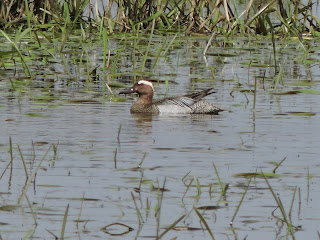Over the last few weeks we’ve also been treated to spectacular views of Hobbies, (on Wheldrake Ings), with up to eight individuals present in the air over and perhaps as many as 13 in the wider LDV area. These birds really are aerial masters, expertly catching dragonflies (and even mayflies and other insects) in their talons before passing them to their beaks to eat on the wing as they continue to feed over the pool. Pool and Swantail Hide are the best places to view them at present, particularly during the afternoon, with birds often coming lower and closer towards dusk as their insect prey descends. Hobbies are the only falcon in Britain that spend the winter months in North Africa, coming to the UK from mid-April and staying until late September and early October, so enjoy them whilst you can! Many thanks to local birder David Gilfillan for the use of his superb photograph taken recently from Swantail Hide, Wheldrake.
Pages
- Home
- May 25
- Apr' 25
- Mar' 25
- Feb' 25
- Jan' 25
- Dec' 24
- Nov' 24
- Oct' 24
- Sep' 24
- Aug' 24
- July 24
- June 24
- May 24
- Apr' 24
- Mar' 24
- Feb' 24
- Jan' 24
- Dec' 23
- Nov' 23
- Oct' 23
- Sep' 23
- Aug' 23
- July 23
- June 23
- May 23
- Apr' 23
- Mar' 23
- Feb' 23
- Jan' 23
- Dec' 22
- Nov' 22
- Oct' 22
- Sept' 22
- Aug' 22
- Jul' 22
- Jun' 22
- May 22
- Apr' 22
- Mar' 22
- Feb' 22
- Jan' 22
- Dec' 21
- Nov' 21
- Oct' 21
- Sep' 21
- Aug' 21
- Jun' 21
- Jul' 21
- Mar' 21
- May 21
- Apr' 21
- Feb' 21
- Nov' 20
- Jan' 21
- Dec' 20
Welcome to the LDV NNR ringing blog, this blog is designed to share the experiences, findings and tales from a group of dedicated ringers. We specialise in conservation orientated research projects, largely focusing on wildfowl, waders, owls and birds of conservation concern, in and around the Vale of York NNR's.
NB - Whilst the purpose of this blog was initially designed to cover our nationally important wildfowl ringing activities, it now also features wildlife and work posts, explaining how we manage the NNR for both wildlife and people.
For daily sightings please visit our Twitter account: https://twitter.com/ldv_nnr (@LDV_NNR)
For details of events, volunteer tasks and wildlife images please visit our Facebook account: https://www.facebook.com/Lower-Derwent-Valley-Skipwith-Common-NNR
Thursday, 31 May 2018
20/05/18 - Corncrakes, Hobbies & Garganey
Over the last few weeks we’ve also been treated to spectacular views of Hobbies, (on Wheldrake Ings), with up to eight individuals present in the air over and perhaps as many as 13 in the wider LDV area. These birds really are aerial masters, expertly catching dragonflies (and even mayflies and other insects) in their talons before passing them to their beaks to eat on the wing as they continue to feed over the pool. Pool and Swantail Hide are the best places to view them at present, particularly during the afternoon, with birds often coming lower and closer towards dusk as their insect prey descends. Hobbies are the only falcon in Britain that spend the winter months in North Africa, coming to the UK from mid-April and staying until late September and early October, so enjoy them whilst you can! Many thanks to local birder David Gilfillan for the use of his superb photograph taken recently from Swantail Hide, Wheldrake.




No comments:
Post a Comment